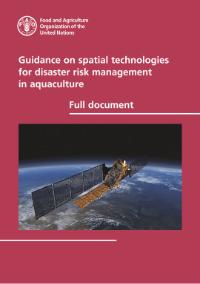Guidance on spatial technologies for disaster risk management in aquaculture
Resource information
Date of publication
Décembre 2018
Resource Language
ISBN / Resource ID
FAODOCREP:CA2240EN
Pages
312
License of the resource
Copyright details
© FAO. FAO is committed to making its content freely available and encourages the use, reproduction and dissemination of the text, multimedia and data presented. Except where otherwise indicated, content may be copied, printed and downloaded for private study, research and teaching purposes, and for use in non-commercial products or services, provided that appropriate acknowledgement of FAO as the source and copyright holder is given and that FAO's endorsement of users' views, products or services is not stated or implied in any way.
This new guide describes the application of spatial technology to improve disaster risk management (DRM) within the aquaculture sector. DRM requires interrelated actions and activities to ensure early warning, prevention, preparedness, response and recovery for a wide range of natural, technological and complex disasters that can impact aquaculture operations and livelihoods.
Spatial technology refers to systems and tools that acquire, manage and analyse data that have geographic context. Some of the technologies include satellite remote sensing, aerial surveys, global positioning systems, geographic information systems, information and communication technology and other data gathering sensors used, for instance, in meteorology. Spatial technology supports activities across all phases of the DRM cycle and its rapid development provides enhanced opportunities to support DRM within the aquaculture sector.This guide is organized in two parts. Part one is the “guidance”; it is the main body of the document and describes the processes and steps for the use of spatial technology within DRM for aquaculture. Part two includes selected country case studies from Bangladesh, the Gulf of Mexico and the Caribbean, and Indonesia to illustrate the application of spatial technology in DRM for aquaculture at the national level within local contexts. Best practices at the farm and area management levels, supported by spatial technology, reduce volatility and risks and thus facilitate investment. Countries that would like aquaculture to grow sustainably and reliably are encouraged to use this guide in order to support spatial planning approaches and protect responsible investors.A separate summary version accompanies this publication.

